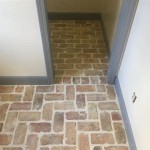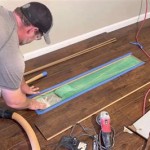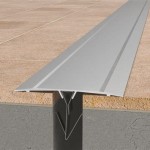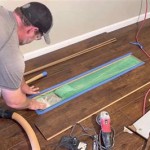How To Put Tile On Concrete Floor In Basement
Transforming a basement floor with tile can significantly enhance its aesthetic appeal and functionality. Tile offers durability, water resistance, and a wide range of design options, making it a popular choice for basement finishing projects. However, successfully installing tile on a concrete basement floor requires careful planning, preparation, and execution. This article provides a comprehensive guide to the process, covering essential steps from assessing the concrete slab to applying the final grout.
Before embarking on the tiling project, it is crucial to understand the properties and limitations of concrete. Concrete is porous and susceptible to moisture, which can lead to tile failure if not properly addressed. Furthermore, the concrete slab must be structurally sound and free from significant cracks or unevenness. Addressing these issues upfront will ensure a long-lasting and visually appealing tile installation.
The following sections detail the steps involved in tiling a concrete basement floor, providing practical advice and highlighting potential challenges.
Assessing the Concrete Slab
The first step in any successful tiling project is to thoroughly assess the condition of the concrete slab. This assessment will determine the necessary preparation steps and identify potential problems that need to be addressed before tiling can begin.
Begin by visually inspecting the concrete floor for any cracks, holes, or unevenness. Small hairline cracks are generally not a cause for concern, but larger cracks, especially those that are wider than 1/8 inch, may indicate structural issues that require professional attention. Similarly, significant holes or depressions in the concrete surface should be filled with a concrete patching compound to create a level surface.
Next, check the floor for levelness. A level floor is essential for a professional-looking tile installation. Use a long level (at least 6 feet) to check for variations in height across the floor. Significant unevenness may require the application of a self-leveling compound to create a flat, even surface.
Moisture testing is another critical aspect of assessing the concrete slab. Basements are often prone to moisture issues, and excessive moisture in the concrete can lead to tile delamination or mold growth. Several methods can be used to test for moisture, including the plastic sheet test and the calcium chloride test. The plastic sheet test involves taping a square of plastic sheeting to the concrete floor for 24-48 hours and observing for condensation under the plastic. The calcium chloride test, which is more accurate, involves placing a container of calcium chloride on the concrete floor and measuring the amount of moisture it absorbs over a specific period. The results of the moisture test will determine whether a moisture barrier is needed before tiling.
Finally, clean the concrete floor thoroughly to remove any dirt, debris, or existing coatings. Sweep or vacuum the floor to remove loose particles, and then scrub it with a concrete cleaner to remove any stains or grease. Rinse the floor thoroughly with clean water and allow it to dry completely before proceeding to the next step.
Preparing the Concrete Surface
Once the concrete slab has been assessed, the next step is to prepare the surface for tiling. Proper preparation is essential for ensuring a strong bond between the tile and the concrete, and for preventing future problems such as cracking or delamination.
If the concrete floor is uneven, apply a self-leveling compound according to the manufacturer's instructions. This will create a flat, even surface that is ideal for tiling. Before applying the self-leveling compound, prime the concrete floor with a concrete primer to promote adhesion. Pour the self-leveling compound onto the floor and spread it evenly with a gauge rake or trowel. Allow the compound to dry completely before proceeding to the next step.
If the moisture test indicates excessive moisture in the concrete, apply a moisture barrier to the floor. A moisture barrier is a waterproof membrane that prevents moisture from migrating up through the concrete and damaging the tile installation. Apply the moisture barrier according to the manufacturer's instructions, ensuring that it is properly sealed at the seams and edges. Some moisture barriers come as a liquid that is applied with a roller, while others are peel-and-stick membranes.
Regardless of whether a moisture barrier is needed, it is generally recommended to apply a concrete primer to the floor before tiling. Concrete primer improves the adhesion of the thin-set mortar and helps to prevent the mortar from drying out too quickly. Apply the primer with a roller or brush, following the manufacturer's instructions. Allow the primer to dry completely before proceeding to the next step.
If the concrete floor is very smooth, it may be necessary to roughen the surface to improve adhesion. This can be done by etching the concrete with a concrete etching solution or by scarifying the surface with a concrete grinder. Follow the manufacturer's instructions carefully when using etching solutions, and wear appropriate protective gear, such as gloves and eye protection.
Installing the Tile
With the concrete surface properly prepared, the final step is to install the tile. This requires careful planning, precise execution, and attention to detail.
Begin by laying out the tile to determine the best placement and to avoid awkward cuts. Start in the center of the room and work outwards, using spacers to maintain consistent grout lines. Pay attention to the layout around doorways, corners, and other obstacles. If necessary, adjust the layout to minimize the number of small or difficult cuts.
Once the layout is determined, mix the thin-set mortar according to the manufacturer's instructions. Use a notched trowel to apply the mortar to the concrete floor, working in small sections at a time. The size of the notches on the trowel will depend on the size and type of tile being used. Hold the trowel at a 45-degree angle and create even ridges in the mortar.
Place the tile onto the mortar, pressing down firmly and twisting slightly to ensure good contact. Use spacers to maintain consistent grout lines between the tiles. Check the tile for levelness and adjust as needed. If the tile is not level, add or remove mortar as necessary.
Continue laying the tile, working in small sections at a time. Periodically check the tile for levelness and alignment. Use a wet saw to cut the tile as needed to fit around doorways, corners, and other obstacles. Wear appropriate safety gear, such as eye protection and ear protection, when using a wet saw.
Once all of the tile has been laid, allow the mortar to dry completely according to the manufacturer's instructions. This typically takes 24-48 hours. After the mortar has dried, remove the spacers and apply grout to the grout lines. Use a grout float to press the grout into the joints, working in a diagonal direction. Remove excess grout with a damp sponge, rinsing the sponge frequently. Allow the grout to dry slightly, and then polish the tile with a clean, dry cloth.
After the grout has dried completely, seal the grout lines with a grout sealer. This will help to protect the grout from stains and moisture. Apply the sealer according to the manufacturer's instructions.
Finally, clean the tile floor thoroughly to remove any remaining grout haze or residue. Use a mild detergent and a soft cloth to clean the tile. Avoid using abrasive cleaners, as they can damage the tile surface.
By following these steps carefully, one can successfully install tile on a concrete basement floor and create a beautiful and functional space.
:max_bytes(150000):strip_icc()/can-you-install-tile-directly-on-concrete-1822600-04-458f7bb6c78348c1835cf8054ef36553.jpg?strip=all)
How To Install Tile Over Concrete

How To Install Tile Over Concrete Greenbuildingadvisor

How To Tile A Concrete Basement Floor The Grout Medic

How To Install Tile In A Basement Washroom Floor On Concrete Like Pro Start Finish

Concrete Basement Floor Tiling Preparation

How To Install Tiles On A Concrete Basement Floor Barana

How To Install Tiles On A Concrete Basement Floor Barana

Finishing Basement Or Porch Put Tile On Concrete Molony Madison Wi Tiles

Thermaldry Basement Flooring Systems Waterproof

Basement Flooring 101 Bob Vila
See Also







